Thu 2 Dec 2010
A 1001 MIDNIGHTS review: DWIGHT V. BABCOCK – A Homicide for Hannah.
Posted by Steve under 1001 Midnights , Authors , Pulp Fiction , Reviews[5] Comments
by Bill Pronzini & Marcia Muller:
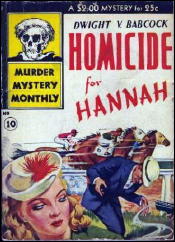
DWIGHT V. BABCOCK – A Homicide for Hannah. Alfred A. Knopf, hardcover, 1941. Pulp magazine reprint: Two Complete Detective Books, November 1941. Paperback reprints: Avon Murder Mystery Monthly #10, 1943; Avon #68, 1945; Avon #332, 1951.
Dwight V. Babcock was a prolific contributor to the pulps in the 1930s, and among the best of the writers developed by Joseph T. “Cap” Shaw, Black Mask’s editor from 1926-1936 and the guiding force in the development of the type of fiction he called “hard, brittle … a full employment of the function of dialogue, and authenticity in characterization and action.”
In 1944, after publishing two of his three mystery novels, Babcock went to work for Universal Studios, for which he scripted numerous films; he also did promotion work for Disney’s The Great Locomotive Chase and worked on other Disney productions.
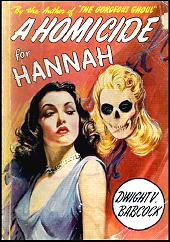
The heroine of all three of his novels, Hannah Van Doren, has an angelic appearance that would lend itself to a Disney movie; this innocent facade, however, is at great odds with her connoisseur’s passion for murder and mayhem.
Not for nothing is she known as “Homicide Hannah, the Gorgeous Ghoul” — even though her interest is purely professional (she writes for True Crime Cases magazine) and her background made that interest inevitable (her father was an L.A. homicide cop).
In this, Hannah’s first adventure, she teams with Joe Kirby, an out-of-work custom-car salesman, to solve the murder of Steve Wurtzel, a gambling buddy of Joe’s who turns up knifed in his (Kirby’s) apartment on Christmas Day.
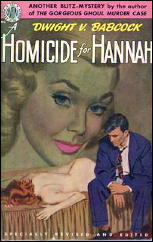
The situation is further complicated by two facts: one, on Christmas Eve Kirby rescued a beaten (and very naked) young woman from an alley and gave her shelter, but she has now disappeared; and two, in her place is Wurtzel’s corpse and a Christmas present left by Kirby’s wealthy girlfriend, Veronica Smith (“Miss Gotrocks” ), whom he is afraid committed the murder.
When Hannah learns of these events, she reacts as if Joe has given her a Christmas present: a homicide for Hannah. She and Joe chase all over Hollywood and environs, bucking heads with, among others: wisecracking reporters; hard-boiled cops; the idle (and not so idle) rich; a man with a face that looks like a skeleton; frequenters of the track at Santa Anita (where Veronica’s horse, Princess Pat, is running on opening day); and a chemist who works for a firm that manufactures “Protexu,” a patented sanitary toilet seat cover.
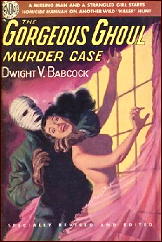
Babcock’s style here is less hard-boiled than in his Black Mask and other pulp work: there is plenty of breezy humor to go along with the fast action, and some delightful glimpses into the mad social whirl of Hollywood just prior to World War II.
Hannah is a lively and irrepressible character — and as it turns out, a very good detective. A Homicide for Hannah is good fun from start to finish.
Hannah’s other two adventures are The Gorgeous Ghoul (1941), in which she and Joe set out to collect a fat reward by returning a missing college boy to his family and in so doing run afoul of murder, a crazy inventor with the instincts of a Peeping Tom, and a very unusual matriarch named Sybil; and Hannah Says Foul Play! (1946), in which Hannah and Joe travel to Palm Springs during its annual western-days celebration and become mixed up in the murder of a Hollywood gossip columnist.
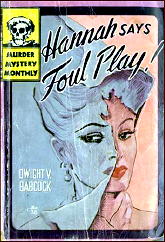
The latter title was published only in digest paperback form, as part of the Avon Murder Mystery Monthly series. Babcock’s only other novel is a collaboration with fellow pulp writer Day Keene — Chautauqua (1960), a mainstream historical with strong suspense elements, published under the joint byline of Day Keene and Dwight Vincent.
———
Reprinted with permission from 1001 Midnights, edited by Bill Pronzini & Marcia Muller and published by The Battered Silicon Dispatch Box, 2007. Copyright © 1986, 2007 by the Pronzini-Muller Family Trust.
December 2nd, 2010 at 6:23 pm
It is a mystery to me that no one ever made a movie of any of the Hannah books. They all seem naturals to me, what with a good-looking female detective and stories emphasizing the screwball side of things and made-to-order Hollywood settings.
Of course, in the world of reality, the only book mentioned in the review that was filmed was CHAUTAUQUA, better known as THE TROUBLE WITH GIRLS.
You know the one, the Elvis Presley movie?
December 3rd, 2010 at 8:42 am
Babcock’s 1939 story “Murder on the Gayway” is in THE BLACK LIZARD BIG BOOK OF BLACK MASK STORIES.
December 3rd, 2010 at 10:52 am
I read “A Homicide for Hannah” some years ago, and just didn’t think it was that good, in terms of storytelling, mystery plot or writing. Haven’t read any other Babcock.
I did enjoy the film THE TROUBLE WITH GIRLS.
December 3rd, 2010 at 12:51 pm
Checking out Babcock’s list of stories n the Cook-Miller index, I was surprised to see that he wrote only 50 or so for the pulp magazines.
This may sound like quite a few, but compared to other pulp fiction authors who wrote hundreds, it’s a mere drop in the bucket.
I thought he’d written more than this, but apparently not so.
Babcock and his wife were friends with Norbert Davis, another well-known pulp writer, and both of his two wives. Photos of their social get-togethers can be found on the main M*F website:
https://mysteryfile.com/NDavis/Wit.html
Scroll down the page to reach the photo gallery.
It’s been too long since I read HOMICIDE FOR HANNAH, and I don’t remember reading the other two at all. Nonetheless, based on 40 year old memories, I’d concur with Bill and Marcia in calling it “breezy humor” and “good fun,” but in terms of the solid mystery plotting I have a feeling you were looking for, Mike, I think you’re right. It wasn’t there.
December 3rd, 2010 at 4:09 pm
Steve,
I’ll keep reading Babcock. The new Black Mask anthology looks great!